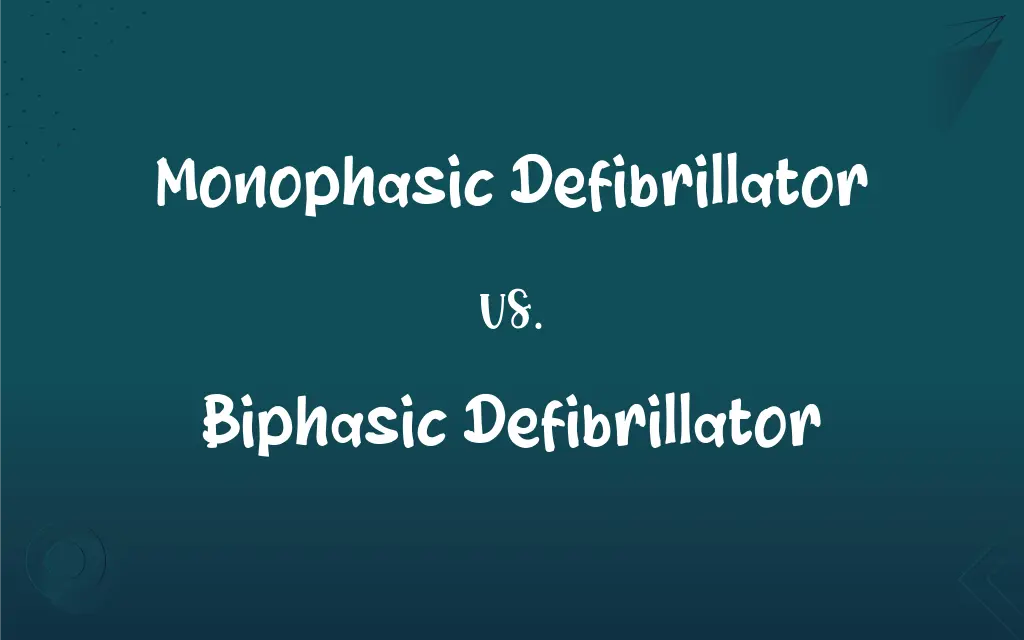Monophasic Defibrillator vs. Biphasic Defibrillator: What's the Difference?
Edited by Aimie Carlson || By Harlon Moss || Updated on October 10, 2023
Monophasic defibrillators deliver an electric shock in one direction, while biphasic defibrillators deliver shocks in two phases, proving more effective with less energy.

Key Differences
Monophasic defibrillators work by sending a single shock from one electrode to the other, passing through the heart to interrupt a chaotic heart rhythm. This type of defibrillation has been in use for several decades and has proven its capability to save lives in instances of heart-related emergencies. The monophasic defibrillator utilizes a single, straightforward pulse to jolt the heart.
Conversely, biphasic defibrillators administer an electric shock in two phases: first in one direction, and then in the reverse, making two-way traffic. Medical professionals have recognized the biphasic defibrillator as being more efficient in resetting the heart's rhythm with lower energies and potentially less damage to the myocardial cells, which gives it an edge over its monophasic counterpart.
While both monophasic and biphasic defibrillators fundamentally serve the same purpose - to interrupt and potentially reset a chaotic cardiac rhythm - their methodologies and efficacies are quite distinct. The monophasic defibrillator, being the elder of the two technologies, utilizes a method that is generally considered less efficient in comparison to more modern biphasic defibrillator technologies.
The biphasic defibrillator has become increasingly prevalent in both hospital settings and in public defibrillation devices due to its enhanced efficacy and safety. These devices have demonstrated superior performance in clinical settings, particularly concerning the successful conversion of ventricular fibrillation and in instances of atrial fibrillation, showcasing a pivotal evolutionary step in defibrillation technology.
Both the monophasic defibrillator and the biphasic defibrillator continue to coexist in various medical environments, although the latter is often favored when available due to its updated technology and improved efficacy. The choice between the two can depend on numerous factors, including the specific medical scenario, availability, and practitioner preference.
ADVERTISEMENT
Comparison Chart
Shock Direction
Single direction
Two-phase, reversible direction
Energy Usage
Generally uses higher energy levels
Uses lower energy levels
Efficacy
Lower efficacy in some arrhythmias
Higher efficacy especially in resistant arrhythmias
Safety and Myocardial Damage
Potentially more myocardial damage due to higher energy usage
Considered safer and causes less myocardial damage
Contemporary Usage
Becoming outdated but still in use
More commonly used and considered standard in many areas
ADVERTISEMENT
Monophasic Defibrillator and Biphasic Defibrillator Definitions
Monophasic Defibrillator
The monophasic defibrillator generates a singular electrical wave, which is deployed with the intention of re-establishing a regular heart rhythm.
In the rural clinic, the availability of a monophasic defibrillator proved vital in managing patients experiencing sudden cardiac episodes.
Biphasic Defibrillator
Leveraging dual-directional electrical waves, biphasic defibrillators aim to efficiently re-establish normal cardiac activity.
The paramedic swiftly employed a biphasic defibrillator, which was instrumental in saving the athlete who collapsed during the match.
Monophasic Defibrillator
A monophasic defibrillator is a medical device that delivers a single, direct electrical shock to the heart.
The emergency team used a monophasic defibrillator to administer a shock and attempt to stabilize the patient's heart rhythm.
Biphasic Defibrillator
Biphasic defibrillators, recognized for reduced electrical energy requirements, are prevalent in automated external defibrillators (AEDs) due to their efficacy and safety profile.
The airport's emergency team utilized a biphasic defibrillator, embedded within an AED, to assist a passenger in cardiac distress, thus preventing a potential tragedy.
Monophasic Defibrillator
The monophasic defibrillator sends an electrical charge in one direction across the heart to terminate a problematic rhythm.
During the cardiac arrest scenario in the simulation lab, we practiced using a monophasic defibrillator to gain proficiency in emergency procedures.
Biphasic Defibrillator
The biphasic defibrillator, offering a two-phase electric shock, is commonly utilized in both pre-hospital and in-hospital emergency care for cardiac arrest situations.
In the intensive care unit, a biphasic defibrillator was kept on standby to manage any abrupt cardiac incidents.
Monophasic Defibrillator
Monophasic defibrillators, while somewhat traditional, are still utilized in certain healthcare and emergency situations to address life-threatening cardiac arrhythmias.
Despite the advent of biphasic technology, the medical team opted for a monophasic defibrillator due to its availability during the crisis.
Biphasic Defibrillator
Distinguished by its dual-phase shock delivery, a biphasic defibrillator minimizes cardiac muscle damage while optimizing electrical efficiency.
The doctor explained how the biphasic defibrillator, by mitigating myocardial damage, presented a safer option for patients needing defibrillation.
Monophasic Defibrillator
Utilizing one phase or pulse of electricity, a monophasic defibrillator aims to reset the heart’s rhythm.
His life was saved when the monophasic defibrillator restored his heart to a normal rhythm during a critical moment.
Biphasic Defibrillator
A biphasic defibrillator employs two-phase electrical waves to restore normal heart rhythms by sending shocks in two directions.
During the emergency, the biphasic defibrillator successfully reverted the patient’s fibrillation, stabilizing their condition.
FAQs
Can both types of defibrillators be used in all medical emergency situations?
Both can be used in emergencies, but the choice might depend on availability, specific patient needs, and practitioner preference, with biphasic often favored due to higher efficacy.
Are monophasic defibrillators still in use today?
Yes, monophasic defibrillators are still in use, though they’re gradually being phased out in favor of biphasic models in many settings due to the latter's improved safety and efficacy.
Can the average person use a biphasic defibrillator in emergency scenarios?
Yes, biphasic defibrillators, especially Automated External Defibrillators (AEDs), are designed to be user-friendly for laypersons during emergencies with clear instructions.
Is the application of monophasic and biphasic defibrillators painful for patients?
Patients generally do not recall the shocks due to altered consciousness during cardiac arrest, but muscle soreness post-resuscitation is common.
Is one type of defibrillator safer than the other?
Biphasic defibrillators are often considered safer due to their utilization of lower energy levels, which minimizes the risk of potential damage to the heart muscle.
How does a biphasic defibrillator function differently?
Biphasic defibrillators provide a two-phase electrical shock, first in one direction and then in the opposite, offering effective rhythm restoration with lesser energy.
How is the energy level determined for defibrillation with a monophasic defibrillator?
Monophasic defibrillators typically use higher energy levels, often determined by medical protocols, patient factors, and practitioner judgment.
Why is a biphasic waveform now often recommended over monophasic?
The biphasic waveform is recommended due to its higher efficacy in arrhythmia conversion, lower required energy, and reduced myocardial damage.
Can the use of a monophasic defibrillator cause harm to the heart?
While monophasic defibrillators have saved numerous lives, their higher energy shocks can potentially cause more damage to the heart muscle compared to biphasic defibrillators.
In what settings would you typically find a biphasic defibrillator today?
Biphasic defibrillators are prevalent in various settings, including hospitals, emergency response vehicles, and public spaces like airports and malls, as AEDs.
How quickly should a defibrillator be utilized in a cardiac arrest scenario?
Immediate use of a defibrillator is ideal in a cardiac arrest due to shockable rhythms to maximize chances of survival.
Can defibrillators be utilized on pediatric patients?
Yes, with appropriate energy settings and electrode sizes, defibrillators can be used on pediatric patients following pediatric advanced life support (PALS) guidelines.
How crucial is defibrillator use during cardiac arrest?
Defibrillator use is vital during cardiac arrest as it can significantly enhance survival rates by promptly addressing life-threatening arrhythmias.
Are defibrillators the only intervention used during cardiac arrest?
No, defibrillators are one component of Advanced Cardiac Life Support (ACLS), which includes chest compressions, ventilation, and potentially medications.
Can defibrillators be used more than once during a resuscitation attempt?
Yes, defibrillators might be used multiple times during resuscitation, depending on the persistence or recurrence of abnormal rhythms.
Why are biphasic defibrillators considered more efficient?
Biphasic defibrillators are deemed more efficient due to their ability to successfully convert arrhythmias using lower energy shocks, thereby reducing potential cardiac damage.
What is the preferred energy level for biphasic defibrillators?
Biphasic defibrillators generally require lower energy levels, with exact amounts guided by manufacturer recommendations and clinical judgment.
What training is required to use a monophasic or biphasic defibrillator?
Medical professionals undergo specific training, while laypersons using AEDs (often biphasic) can often follow the automated voice instructions, with formal training also available.
What is a monophasic defibrillator?
A monophasic defibrillator delivers a single-phase, unidirectional electrical shock to terminate irregular heart rhythms.
Is there a maximum number of shocks that can be delivered to a patient?
There is no strict maximum, but the number and energy of shocks should be balanced against potential harms and the overall clinical picture.
About Author
Written by
Harlon MossHarlon is a seasoned quality moderator and accomplished content writer for Difference Wiki. An alumnus of the prestigious University of California, he earned his degree in Computer Science. Leveraging his academic background, Harlon brings a meticulous and informed perspective to his work, ensuring content accuracy and excellence.
Edited by
Aimie CarlsonAimie Carlson, holding a master's degree in English literature, is a fervent English language enthusiast. She lends her writing talents to Difference Wiki, a prominent website that specializes in comparisons, offering readers insightful analyses that both captivate and inform.































































